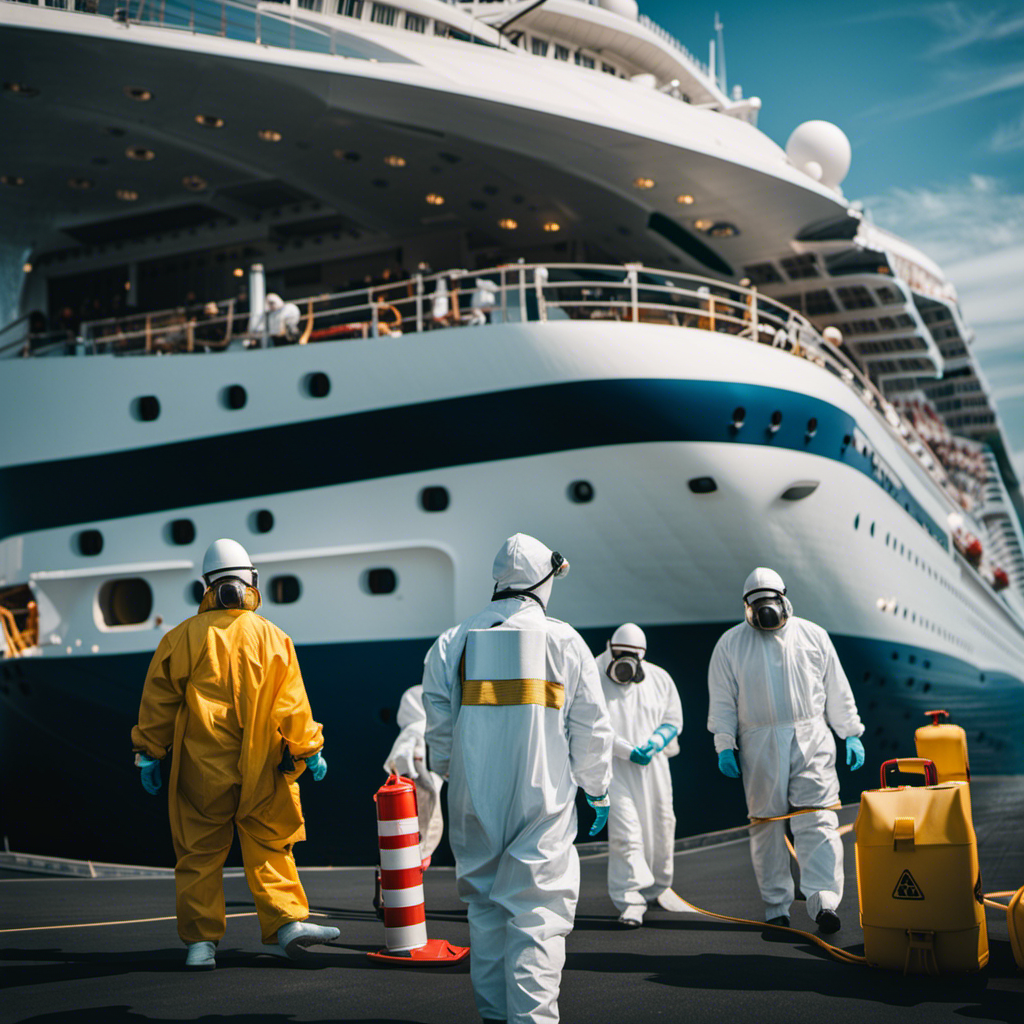Consistent with the timeless saying, ‘Smooth sailing is never guaranteed.’ When it comes to holiday cruises, the emergence of diseases can dampen the spirits. Nonetheless, fear not, esteemed voyagers, for in this article, I will uncover the truths about health issues on cruise liners and shed light on the measures being taken to safeguard the well-being of all onboard, both the guests and the staff.
From seasickness remedies to the infamous norovirus outbreaks and the current impact of COVID-19, we will explore it all.
You might be wondering, why do cruise ships often get a bad rap for illnesses? Well, the truth is that cruise ships are required to report gastrointestinal illness cases, making it seem like they have more cases than other places. But don’t let that deter you from setting sail. Cruise lines are working diligently with the CDC to develop safety protocols, including reduced capacity, changes in buffet operations, and temperature checks.
So, grab your life jacket and prepare for a journey through the facts and myths surrounding cruise ship illnesses. It’s time to set sail on an informative adventure!
Key Takeaways
- Seasickness is not contagious but can disrupt vacations. Remedies include prescription medicated patches, over-the-counter pills, copper wristbands, ginger candies, and green apples.
- Norovirus outbreaks on cruise ships account for a small percentage of reported cases. Cruise ships are subject to random inspections by CDC-trained officials.
- Cruises for North Americans are unlikely to resume until at least early 2021 due to COVID-19. Cruise lines are working with the CDC to develop protocols to minimize infection.
- Ways to minimize germ sharing on cruises include frequent handwashing, using hand sanitizer, avoiding touching the face, using serving utensils, carrying disinfectant wipes or hand sanitizer, and wearing a mask.
Causes and Prevention
I’ve learned that cruise ship illnesses can be caused by various factors, such as seasickness, norovirus outbreaks, and now even COVID-19. But there are preventive measures that can be taken to minimize the risk of getting sick on a cruise.
One important aspect to consider is cruise ship hygiene. Maintaining good hygiene practices, such as frequent handwashing and using hand sanitizer, can greatly reduce the spread of germs. Additionally, avoiding touching the face and using serving utensils instead of hands can help minimize germ sharing.
It’s also important to be aware of common illnesses that can occur on a cruise, such as seasickness and norovirus. Taking precautions, such as choosing a larger ship and booking a room on a middle deck, midship, and staying hydrated can help minimize the risk of seasickness.
Being informed about the cleanliness and safety measures implemented by the cruise line, such as random inspections and the posting of ship scores and violations, can also provide reassurance.
By following these preventive measures, passengers can enjoy their cruise while minimizing the risk of getting sick.
Seasickness Remedies
Staring at the horizon can help passengers regain their equilibrium, providing a visual anchor against the constant feeling of movement.
While seasickness can disrupt vacations, there are several remedies available to prevent and alleviate symptoms. Prescription medicated patches, over-the-counter pills, copper wristbands, ginger candies, and green apples are commonly used to combat seasickness.
It’s also recommended to stay hydrated and choose a larger ship with a room on a middle deck, midship to reduce the sensation of movement.
In case of severe seasickness, cruise ships are equipped with medical facilities that can provide further assistance. These facilities are staffed with trained medical professionals who can offer treatments such as intravenous fluids or medications to alleviate symptoms.
It’s important for passengers to be aware of these prevention methods and the resources available on board to ensure a more enjoyable cruise experience.
Norovirus Outbreaks
Norovirus outbreaks on cruise ships account for a small percentage of reported cases, with nursing homes, schools, hospitals, and restaurants being more common sources of spread. However, it’s important to understand how norovirus can be transmitted and how to prevent its spread on cruise ships:
-
Proper Hand Hygiene: Washing hands with soap and water for at least 20 seconds is crucial in preventing norovirus transmission. Hand sanitizers should be used when soap and water aren’t available.
-
Proper Food Handling: Cruise ships should adhere to strict food safety practices to prevent contamination. This includes proper storage, cooking, and serving of food to minimize the risk of norovirus outbreaks.
-
Enhanced Cleaning and Disinfection: Frequent cleaning and disinfection of high-touch surfaces, such as handrails and elevator buttons, can help reduce the spread of norovirus.
-
Isolation and Reporting: Cruise ships should have protocols in place to identify and isolate individuals with symptoms of norovirus. Prompt reporting of cases to health authorities is essential to prevent further spread.
By following these preventive measures, cruise ships can minimize the risk of norovirus outbreaks and ensure a safe and enjoyable experience for passengers.
COVID-19 Safety Protocols
COVID-19 safety protocols on cruise ships have been developed in collaboration with the CDC to minimize the risk of infection. As part of these protocols, cruise lines are implementing vaccination requirements for passengers and crew members. This is an important step to ensure the safety of everyone on board and to prevent the spread of the virus.
The impact of these vaccination requirements on the cruise industry has been significant. Some individuals may choose not to cruise due to these requirements, while others may feel more confident in booking a cruise knowing that everyone on board is vaccinated.
It’s important for cruise lines to communicate and enforce these requirements effectively to regain the trust of passengers and to create a safe and healthy environment for everyone on board.
Minimizing Germ Sharing
To minimize the sharing of germs on a cruise, I always make sure to frequently wash my hands, use hand sanitizer, and avoid touching my face. These simple practices can go a long way in preventing the spread of illnesses. In addition to personal hygiene, wearing a mask can also be an effective measure. It acts as a physical barrier, reducing the risk of respiratory droplets containing germs from being released into the air. By wearing a mask, not only am I protecting myself, but I am also protecting those around me. It is important to remember that hand hygiene and mask wearing are not just beneficial on a cruise, but in any crowded setting. By following these guidelines, we can all contribute to a healthier and safer environment onboard.
| Hand Hygiene | Mask Wearing |
|---|---|
| Frequent handwashing | Wear a mask in public areas |
| Use hand sanitizer | Cover nose and mouth properly |
| Avoid touching face | Follow guidelines and regulations |
| Carry disinfectant wipes or hand sanitizer | Be considerate of others |
| Use serving utensils | Protect yourself and others |
Frequently Asked Questions
Are all cruise ship illnesses contagious?
Not all cruise ship illnesses are contagious. While norovirus outbreaks can occur, they account for a small percentage of reported cases. Prevention measures such as handwashing, sanitizing, and following safety protocols help minimize the spread of non-contagious illnesses.
How do cruise ships handle outbreaks of illnesses other than norovirus?
Cruise ship outbreak protocols for non-norovirus illnesses involve isolating affected individuals, implementing enhanced cleaning measures, and providing medical care. In collaboration with health authorities, cruise lines have robust plans to prevent and manage outbreaks effectively.
What are some common misconceptions about cruise ship illnesses?
Common misconceptions about cruise ship illnesses include thinking that seasickness is contagious, that cruise ships have a high rate of norovirus outbreaks, and that COVID-19 protocols are not being developed to minimize infection. Legal implications and compensation may vary in cases of illness.
Are there any long-term effects of contracting an illness on a cruise ship?
Long term health risks of contracting an illness on a cruise ship can vary depending on the specific illness. Medical treatment options are available, including medications and supportive care, to manage symptoms and promote recovery.
How do cruise lines ensure the safety of their passengers and crew during a global pandemic?
Cruise lines ensure the safety of passengers and crew during the COVID-19 pandemic through strict cruise ship safety protocols and COVID-19 prevention measures. These include reduced capacity, changes in buffet operations, temperature checks, and enforcing mask wearing and social distancing.










